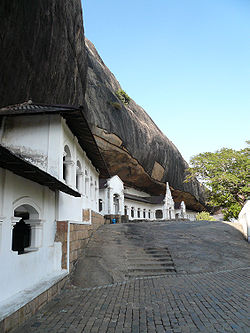This article includes a list of general references, but it lacks sufficient corresponding inline citations. (September 2017) |
Dambulla දඹුල්ල தம்புள்ளை | |
|---|---|
 | |
| Coordinates: 7°51′28″N 80°39′09″E / 7.85778°N 80.65250°E | |
| Country | Sri Lanka |
| Province | Central Province |
| District | Matale District |
| Divisional Secretariat | Dambulla Division |
| Government | |
| • Type | Municipal Council |
| • Body | Dambulla Municipal Council |
| • Mayor | Jaliya Opatha |
| • Deputy Mayor | Sameera Jayasekara |
| Area | |
| • Town | 444.0 km2 (171.4 sq mi) |
| • Urban | 54.0 km2 (20.8 sq mi) |
| Population (2012) | |
| • Town | 72,306 (Dambulla Division) |
| • Density | 162.9/km2 (422/sq mi) |
| • Urban | 23,814 (Dambulla Municipality) |
| • Urban density | 441.0/km2 (1,142/sq mi) |
| Time zone | UTC+5:30 (Sri Lanka Standard Time Zone) |

Dambulla (Sinhala: දඹුල්ල Dam̆bulla, Tamil: தம்புள்ளை Tampuḷḷai) is a town situated in the north of Matale District, in Sri Lanka's Central Province. It is the second largest populated and urbanised centre after Matale in the Matale District. It is situated 148 km (92 mi) north-east of Colombo, 43 km (27 mi) north of Matale and 72 km (45 mi) north of Kandy. Due to its location at a major junction, it is the centre of major vegetable distribution in the country.
Major attractions of the area include the largest and best preserved cave temple complex of Sri Lanka, sigiriya rock fortress located in the division and the Rangiri Dambulla International Stadium, famous for being built in just 167 days. The area also boasts the largest rose quartz mountain range in South Asia, and the Iron wood forest, or Na Uyana Aranya.
Ibbankatuwa prehistoric burial site near Dambulla cave temple complexes is the latest archaeological site of significant historical importance found in Dambulla, which is located within 3 km (1.9 mi) of the cave temples providing evidence of the presence of indigenous civilisations long before the arrival of Indian influence on the Island nation.
